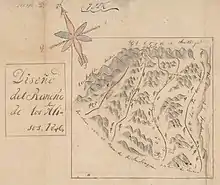Rancho Cañada de los Alisos
Rancho Cañada de los Alisos was a 10,668-acre (43.17 km2) Mexican land grant in present-day Orange County, California given by Governor Juan Bautista Alvarado to Jose Antonio Fernando Serrano in 1842, and enlarged by a second grant by Pio Pico in 1846.[1] The name means "Glen of the Alders" in Spanish, after the native White Alder (Alnus rhombifolia) trees growing there. The rancho included the present day cities of Lake Forest (formerly El Toro), and the Marine Corps Air Station El Toro—Orange County Great Park site in Irvine.[2][3][4][5]

History
Jose Antonio Fernando Serrano (1804-1870) was granted Rancho Cañada de Los Alisos in 1842. Serrano married Maria Petra Avila. Serrano and his sons raised crops to sell, however, their principal industry was cattle, from which hides and tallow were sold.[6]
With the cession of California to the United States following the Mexican-American War, the 1848 Treaty of Guadalupe Hidalgo provided that the land grants would be honored. As required by the Land Act of 1851, a claim for Rancho Cañada de los Alisos was filed with the Public Land Commission in 1852,[7][8] and the grant patented to Jose Antonio Fernando Serrano in 1871.[9]
A series of droughts, beginning in 1863 and lasting intermittently through 1883, forced the Serrano family to divide the ranch and mortgage several sections. Unfortunately, the drought of 1863 and 1864 caused the death of Serrano's herds, forcing foreclosure of the ranch to Los Angeles banker J.S. Slauson. Slauson divided the ranch into ten parcels, the largest being 10,000 acres (40 km2). Bostonian Dwight Whiting purchased most of the rancho in 1884. Whiting developed it as an English village named Aliso City. Whiting encouraged development by subdividing level land, bringing the railroad through, and by planting olive trees, grape vineyards and some 400 acres (1.6 km2) of eucalyptus trees. However, due to the arid climate and poor soil, agricultural use was unsuccessful. In 1959, the remaining Whiting properties were sold to V.P. Baker and Associates, and residential development has since ensued.[10][11]
Historic sites of the Rancho
- Jose Serrano Adobe. The Serrano Adobe was built by Jose Antonio Fernando Serrano in about 1863. It is the second of five adobes built by the Serranos on this Mexican land grant and the only one still remaining.[12]
References
- Ogden Hoffman, 1862, Reports of Land Cases Determined in the United States District Court for the Northern District of California, Numa Hubert, San Francisco
- Diseño del Rancho Cañada de los Alisos
- Diseño del Rancho de los Alisos
- U.S. Geological Survey Geographic Names Information System: Rancho Cañada de los Alisos
- Spanish and Mexican Ranchos of Orange County Archived 2011-07-26 at the Wayback Machine
- Hoover, Mildred B.; Rensch, Hero; Rensch, Ethel; Abeloe, William N. (1966). Historic Spots in California. Stanford University Press. ISBN 978-0-8047-4482-9.
- United States. District Court (California : Southern District) Land Case 31 SD
- Finding Aid to the Documents Pertaining to the Adjudication of Private Land Claims in California, circa 1852-1892
- Report of the Surveyor General 1844 - 1886 Archived 2013-03-20 at the Wayback Machine
- History Limestone Canyons & Whiting Ranch Wilderness Park Archived 2011-07-18 at the Wayback Machine
- Find a grave
- Whiting-Jose Serrano adobe on Rancho Cañada de Los Alisos, 1935
